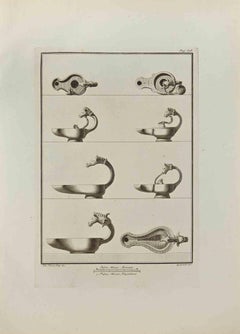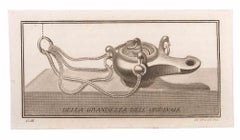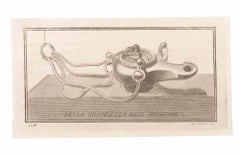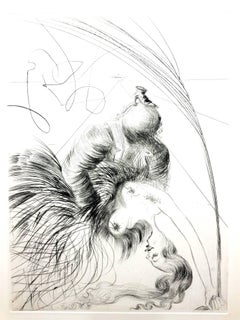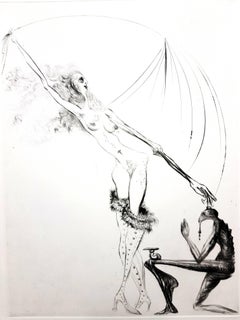Filippo de Grado Still-life Prints
1
to
9
6
3
6
3
Overall Height
to
Overall Width
to
9
2
2
2
1
1
1
1
1
1
1
1
1
1
1
1
1
9
9
27
129
126
58
47
9
Artist: Filippo de Grado
Oil Lamp With Heads of Animals - Etching by Filippo de Grado - 18th Century
By Filippo de Grado
Located in Roma, IT
Oil Lamp With Heads of Animals from "Antiquities of Herculaneum" is an etching on paper realized by Filippo De Grado in the 18th Century.
Signed on the plate.
Good conditions.
The etching belongs to the print suite “Antiquities of Herculaneum Exposed” (original title: “Le Antichità di Ercolano Esposte”), an eight-volume volume of engravings of the finds from the excavation of the ruins of Herculaneum in the Kingdom of Naples (now Campania, Italy).
It was published between 1757 and 1792 by the Regia Stamperia, and copies were delivered to selected recipients across Europe.
Despite the title, the Antiquity of Herculaneum shows objects from all the excavations undertaken by the Bourbons in the Gulf of Naples. These include Pompeii, Stabia and two sites of Herculaneum: Resina and Portici.
The Bourbon King Carlo appointed fifteen scholars creating a new “Herculaneum Academy” to study the artifacts and publish the results of the archaeological excavations of the sites.
The engravings are of high quality and the accompanying text shows a large scholarship.
They were realized by 25 prominent artists involved by the King to prepare drawings and engravings on the finds, among which we can find Giovanni Elia Morghen, Carlo Nolli, Luigi Vanvitelli, and Giovanni Battista Casanova.
The “Antiquities” was designed more to amaze readers with the quality of the objects in the collection of the King of Naples than to be used in research., following and increasing the interest of 18th-century society for the classical culture and Art in particular.
Through the exaltation of the classical concept of proportions and harmony, the book was of inspiration to the neoclassical movement in Europe, giving artists and decorators access to a huge shop of Hellenistic motifs.Oil Lamp With Animals...
Category
18th Century Old Masters Filippo de Grado Still-life Prints
Materials
Etching
Temple With Sphinx - Etching by Filippo de Grado - 18th Century
By Filippo de Grado
Located in Roma, IT
Temple With Sphinx from "Antiquities of Herculaneum" is an etching on paper realized by Filippo De Grado in the 18th Century.
Signed on the plate.
Good conditions and aged with som...
Category
18th Century Old Masters Filippo de Grado Still-life Prints
Materials
Etching
Oil Lamp to Hang - Etching by Filippo de Grado - 18th Century
By Filippo de Grado
Located in Roma, IT
Oil Lamp to Hang is an Etching realized by Filippo de Grado (1705-1780).
The etching belongs to the print suite “Antiquities of Herculaneum Exposed” (original title: “Le Antichità ...
Category
18th Century Old Masters Filippo de Grado Still-life Prints
Materials
Etching
Oil Lamp to Hang - Etching by Filippo de Grado - 18th Century
By Filippo de Grado
Located in Roma, IT
Oil Lamp to Hang is an Etching realized by Filippo de Grado (1705-1780).
The etching belongs to the print suite “Antiquities of Herculaneum Exposed” (original title: “Le Antichità ...
Category
18th Century Old Masters Filippo de Grado Still-life Prints
Materials
Etching
Oil Lamp With Decoration - Etching by Filippo de Grado - 18th Century
By Filippo de Grado
Located in Roma, IT
Oil Lamp With Decoration is an Etching realized by Filippo de Grado (1705-1780).
The etching belongs to the print suite “Antiquities of Herculaneum Exposed” (original title: “Le An...
Category
18th Century Old Masters Filippo de Grado Still-life Prints
Materials
Etching
Oil Lamp to Hang - Etching by Filippo de Grado - 18th Century
By Filippo de Grado
Located in Roma, IT
Oil Lamp to Hang is an Etching realized by Filippo de Grado (1705-1780).
The etching belongs to the print suite “Antiquities of Herculaneum Exposed” (original title: “Le Antichità ...
Category
18th Century Old Masters Filippo de Grado Still-life Prints
Materials
Etching
Cupid In Pompeian Fresco - Etching by Filippo de Grado - 18th Century
By Filippo de Grado
Located in Roma, IT
Cupid In Pompeian Fresco from "Antiquities of Herculaneum" is an etching on paper realized by Filippo De Grado in the 18th Century.
Signed on the plate.
Good conditions with some f...
Category
18th Century Old Masters Filippo de Grado Still-life Prints
Materials
Etching
Oil Lamp to Hang - Etching by Filippo de Grado - 18th Century
By Filippo de Grado
Located in Roma, IT
Oil Lamp to Hang is an Etching realized by Filippo de Grado (1705-1780).
The etching belongs to the print suite “Antiquities of Herculaneum Exposed” (original title: “Le Antichità ...
Category
18th Century Old Masters Filippo de Grado Still-life Prints
Materials
Etching
Ancient Still Life 4 - Etching by Filippo de Grado - 18th Century
By Filippo de Grado
Located in Roma, IT
Still Life from "Antiquities of Herculaneum" is an etching on paper realized by Filippo de Grado e Vincenzo Campana in the 18th Century.
Signed on the plate.
Good conditions with s...
Category
18th Century Old Masters Filippo de Grado Still-life Prints
Materials
Etching
Related Items
Salvador Dali - The Woman of the Shoe - Original Stamp-Signed Etching
By Salvador Dalí
Located in Collonge Bellerive, Geneve, CH
Salvador Dali - The Woman of the Shoe - Original Stamp-Signed Etching
Stamp signed by Dali
Edition of 294 copies.
Paper : Arches vellum.
Dimensions : 16x12".
Catalogue Raisonné : ...
Category
1960s Surrealist Filippo de Grado Still-life Prints
Materials
Etching
H 16 in W 12 in D 0.1 in
Salvador Dali - The Violet Boot - Original Stamp-Signed Etching
By Salvador Dalí
Located in Collonge Bellerive, Geneve, CH
Salvador Dali - The Violet Boot - Original Stamp-Signed Etching
Stamp signed by Dali
Edition of 294 copies.
Paper : Arches vellum.
Dimensions : 16x12".
Catalogue Raisonné : Field ...
Category
1960s Surrealist Filippo de Grado Still-life Prints
Materials
Etching
H 16 in W 12 in D 0.1 in
Piranesi I. / Fine Art Print / Limited
By Giovanni Battista Piranesi
Located in Slovak Republic, SK
High quality Fine Art Print, Hahnemuehle paper, limited edition, could be also delivered framed, certificate of SalamonArt, Giovanni Battista Piranesi,...
Category
Late 18th Century Old Masters Filippo de Grado Still-life Prints
Materials
Archival Pigment
Free Shipping
H 24.81 in W 18.9 in
18th C. Piranesi Fireplace Designs based on Ancient Architectural Styles
By Giovanni Battista Piranesi
Located in Alamo, CA
These two Giovanni Battista Piranesi 18th century etchings of fireplace designs on one sheet is plate 6 from his publication 'Diverse Maniere d'adornare i cammini ed ogni altra parte degli edifizi desunte dall'architettura Egizia, Etrusca, e Greca con un Ragionamento Apologetico in defesa dell'Architettura Egizia, e Toscana, opera del Cavaliere Giambattista Piranesi...
Category
Mid-18th Century Old Masters Filippo de Grado Still-life Prints
Materials
Etching
Amsterdam VIII ed 28/50 - museum glass framed black-white aquatint etch print
By Olivier Julia
Located in Doetinchem, NL
Amsterdam VIII is an intriguing early career aquatint dry-needle etch print by renowned French-Dutch artist Olivier Julia. It depicts a detail of an old Amsterdam house facade is bot...
Category
1980s Contemporary Filippo de Grado Still-life Prints
Materials
Rag Paper, Etching, Aquatint
"Limon Straitus Amalphitanus" Ferrari 17th C. Hand Colored Engraving of Lemons
By Giovanni Battista Ferrari
Located in Alamo, CA
This 17th century hand-colored engraving of a lemon entitled "Limon Straitus Amalphitanus" is Plate 249 from Giovanni Baptista Ferrari's publication "Hesperides, sive, De Malorum Aur...
Category
17th Century Old Masters Filippo de Grado Still-life Prints
Materials
Engraving
H 23.25 in W 18.5 in D 0.75 in
Purple magnolia 3 - Contemporary Figurative Drypoint Etching Print Flower Floral
By Marta Wakula-Mac
Located in Warsaw, PL
MARTA WAKUŁA-MAC: Master of Arts in Fine Art Education- Diploma in Fine Art Printmaking at the Institute of Art, Pedagogical University, Krakow, 2003. Member of Graphic Studio Dubl...
Category
2010s Contemporary Filippo de Grado Still-life Prints
Materials
Paper, Drypoint, Etching
Pomegranates
By Kaiko Moti
Located in San Francisco, CA
This artwork titled "Pomegranates" c.1970 is an original color aquatint on Japan paper by noted Indian artist Kaiko Moti, 1921-1989. It is hand signed and numbered XXII/LXXV in White pencil by the artist. The Size is 22 x 29.25 inches. Printed to the edge. It is in excellent condition, some hanging tape remaining on the back from a previous framing.
About the artist:
Born (Kaikobad Motiwalla) in Bombay, India on December 15, 1921, Moti was first educated at the Bombay School of Fine Arts but his talent led him onwards to study at the University College in London (on scholarship) and at the Slade School of Fine Arts, London, where he received a Master's degree in Painting and Sculpture. While still in London he studied under MacWilliam and Reginald Butler.
Eventually moving to Paris in 1950, Moti attended the Academie de la Grand Chaumiere, Atelier Zadkine, to pursue his love of sculpture but lack of space soon compelled him to turn his attention to working on copper plates and he studied engraving with William Stanley Hayter...
Category
Mid-20th Century Impressionist Filippo de Grado Still-life Prints
Materials
Aquatint
Samuel Bak Surrealist Etching Israeli Bezalel Artist "Hidden Pear", Fruit Bowl
By Samuel Bak
Located in Surfside, FL
HIDDEN PEAR, color etching, signed in pencil, numbered 7/50, Jerusalem Print workshop blind stamp, image 7 ½ x 5 ½”, sheet 15 x 10 ¼”.
Samuel Bak (born 12 August 1933) is a Polish- American painter and writer who survived the Holocaust and immigrated to Israel in 1948. Since 1993, he has lived in the United States.
Samuel Bak was born in Wilno, Poland, Bak was recognized from an early age as having an artistic talent. He describes his family as secular, but proud of their Jewish identity.
By 1939 when Bak was six years old, the war began and Wilno was transferred from Poland to Lithuania. When Wilno was occupied by the Germans on June 24, 1941, Bak and his family were forced to move into the ghetto. At the age of nine, he held his first exhibition inside the Ghetto. Bak and his mother sought refuge in a Benedictine convent where a Catholic nun named Maria Mikulska tried to help them. After returning to the ghetto, they were deported to a forced labour camp, but took shelter again in the convent where they remained in hiding until the end of the war.
By the end of the war, Samuel and his mother were the only members of his extensive family to survive. His father, Jonas, was shot by the Germans in July 1944, only a few days before Samuel's own liberation. As Bak described the situation, "when in 1944 the Soviets liberated us, we were two among two hundred of Vilna's survivors--from a community that had counted 70 or 80 thousand." Bak and his mother as pre-war Polish citizens were allowed to leave Soviet-occupied Wilno and travel to central Poland, at first settling briefly in Lodz. They soon left Poland and traveled into the American occupied zone of Germany. From 1945 to 1948, he and his mother lived in Displaced Persons camps in Germany. He spent most of this period at the Landsberg am Lech DP camp in Germany. It was there he painted a self-portrait shortly before repudiating his Bar Mitzvah ceremony. Bak also studied painting in Munich during this period, and painted "A Mother and Son", 1947, which evokes some of his dark memories of the Holocaust and escape from Soviet-occupied Poland. In 1948, Bak and his mother immigrated to Israel. In 1952, he studied art at the Bezalel Academy of Arts and Design in Jerusalem. After serving in the Israel Defense Forces, he continued his studies in Paris (from 1956 at the École nationale supérieure des Beaux-Arts) and spent various periods of time in Rome, Paris, Switzerland and Israel before settling permanently in the United States. In 2001, Bak returned to Vilnius for the first time and has since visited his hometown several times. Samuel Bak is a conceptual artist with elements of post-modernism as he employs different styles and visual vernaculars, i.e. surrealism (Salvador Dali, Rene Magritte), analytical cubism (Picasso), pop art (Andy Warhol, Roy Lichtenstein) and quotations from the old masters. The artist never paints direct scenes of mass death. Instead, he employs allegory, metaphor and certain artistic devices such as substitution: toys instead of the murdered children who played with them, books, instead of the people who read them. Further devices are quotations of iconographical prototypes, i.e. Michelangelo's "Creation of Adam" on the Sistine Ceiling or Albrecht Dürer's famous engraving entitled "Melencholia" . In the late 1980s Bak opened up about his paintings, stating they convey “a sense of a world that was shattered.” He turns these prototypes into ironical statements. Irony in the art of Samuel Bak does not mean parody or derision, but rather disenchantment, and the attempt to achieve distance from pain. Recurring symbols are: the Warsaw Ghetto Child, Crematorium Chimneys or vast backgrounds of Renaissance landscape that symbolize the indifference of the outside world. These form a disturbing contrast with the broken and damaged images in the foreground. Samuel Bak's paintings cause discomfort, they are a warning against complacency, a bulwark against collective amnesia with reference to all acts of barbarism, worldwide and throughout the ages, through his personal experience of genocide.
In Bak's piece entitled Trains Bak creates a vast grey landscape with large mounts creating the structure of a train. Massive taper candles burn in the distance further down the train tracks, surrounding an eruption. The smoke from the candles and volcano pour into a sky of dark ominous clouds that lurk over the landscape. Here Bak has created a whole new meaning for “trains.” Many of Bak’s pieces incorporate aspects of Jewish culture and the holocaust with a dark and creative twist, such as Shema Israel, Alone, and Ghetto. Chess as a theme of life has always fascinated Bak. In the DP camps and in Israel, he often played chess with his stepfather Markusha. Underground II, 1997, portrays chess pieces in a sunken, subterranean evocation of the Vilna ghetto.
Select Group Exhibitions
Graphic Works by Contemporary Israeli artists - Israel Museum, Jerusalem
Avraham Ofek, Igael Tumarkin, Shmuel Bak, Avigdor Arikha,Jakob Steinhardt, Anna Ticho
Artist and Society in Israeli Art, Tel Aviv Museum, Tel Aviv Moshe Gat, Marcel Janco, Yohanan Simon, Ruth Schloss, Menashe Kadishman, Samuel Bak, Yosl Bergner.
Selected museum exhibitions
Bezalel Museum, Jerusalem, Israel – 1963
Tel Aviv Museum, Tel Aviv, Israel – 1963
Rose Museum, Brandeis University, Waltham, MA – 1976
Germanisches National Museum, Nuremberg, Germany – 1977
Heidelberg Museum, Heidelberg, Germany – 1977
Haifa University, Haifa, Israel – 1978
Kunstmuseum, Düsseldorf, Germany – 1978
Jüdisches Museum, Stadt Frankfurt am Main, Germany – 1993
Hebrew Union College, Jewish Institute of Religion, New York, NY – 1994
South African Jewish Museum, Cape Town, South Africa. 2013-2014.
B’nai B’rith Klutznick National Jewish Museum, Washington, DC – 1997
Holocaust Museum Houston, Houston, TX – 1997
National Museum of Lithuania, Vilnius, Lithuania – 2001
Felix Nussbaum...
Category
20th Century Surrealist Filippo de Grado Still-life Prints
Materials
Etching
Salvador Dali - The Winged Demon - Original Stamp-Signed Etching
By Salvador Dalí
Located in Collonge Bellerive, Geneve, CH
Salvador Dali - The Winged Demon - Original Stamp-Signed Etching
Stamp signed by Dali
Edition of 294 copies.
Paper : Arches vellum.
Dimensions : 16x12"....
Category
1960s Surrealist Filippo de Grado Still-life Prints
Materials
Etching
H 16 in W 12 in D 0.1 in
A Flower Piece
By Jan Van Huysum
Located in Florham Park, NJ
JAN VAN HUYSUM (1682-1749)
“A Flower Piece.” (Shown)
"A Fruit Piece." (Listed Separately)
SOLD ONLY AS A PAIR.
PRICED FOR THE PAIR.
Mezzotint engra...
Category
18th Century and Earlier Old Masters Filippo de Grado Still-life Prints
Materials
Engraving, Watercolor
Magnolia 10 - Contemporary Figurative Drypoint Etching Print, Flower, Floral
By Marta Wakula-Mac
Located in Warsaw, PL
MARTA WAKUŁA-MAC: Master of Arts in Fine Art Education- Diploma in Fine Art Printmaking at the Institute of Art, Pedagogical University, Krakow, 2003. Member of Graphic Studio Dubl...
Category
2010s Contemporary Filippo de Grado Still-life Prints
Materials
Paper, Drypoint, Etching
Filippo De Grado still-life prints for sale on 1stDibs.
Find a wide variety of authentic Filippo de Grado still-life prints available for sale on 1stDibs. You can also browse by medium to find art by Filippo de Grado in etching and more. Much of the original work by this artist or collective was created during the 18th century and is mostly associated with the Old Masters style. Not every interior allows for large Filippo de Grado still-life prints, so small editions measuring 10 inches across are available. Filippo de Grado still-life prints prices can differ depending upon medium, time period and other attributes. On 1stDibs, the price for these items starts at $198 and tops out at $512, while the average work can sell for $245.
